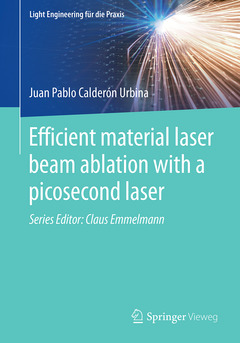Efficient material laser beam ablation with a picosecond laser, 1st ed. 2021 Light Engineering für die Praxis Series
Auteur : Calderón Urbina Juan Pablo

Juan Pablo Calderón Urbina obtained his Bachelor’s degree in Industrial Engineering at the Morelia Institute of Technology in Morelia, Mexico (Instituto Tecnológico de Morelia). He specialized in International Production Management at the Hamburg University of Technology (Technische Universität Hamburg) for his Master of Science’s degree. Until 2013, he collaborated as a research assistant in several research and industrial projects with the Laser Zentrum Nord GmbH. In 2019, he concluded his scientific research and completed his doctorate at the Hamburg University of Technology, in the Institute of Laser and System Technologies (Institut für Laser- und Anlagensystemtechnik, iLAS).
A concise journey through the background and understanding of ultra-short pulse laser technologies
Offers versatile application of quality-oriented tools in laser beam material processing
Describes a single-pulse and multi-pulse model on cemented tungsten carbide capable to be adapted to other materials and laser systems
Date de parution : 07-2020
Ouvrage de 210 p.
16.8x24 cm



